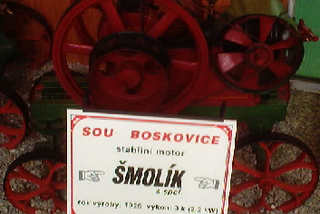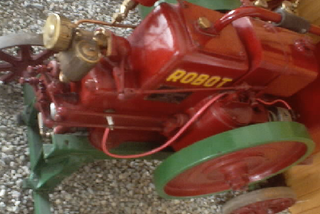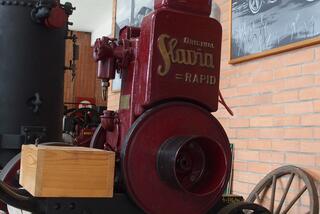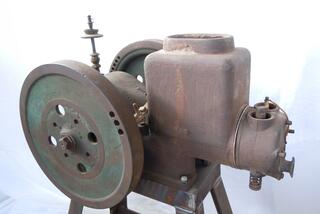
Stable motors
It is no exaggeration to say that the expansion of stable engines after the First World War meant the entry of the industrial revolution not only into the Moravian countryside. Until then, smaller farmers could only rely on human and animal strength. However, working with a stable engine was not easy, as the grandfather Komárek demonstrated to us in the movie Alone in the Forest while cutting wood on a saw powered by a stable Slavia engine.
Lorenc stable motors
The beginnings of the company, which was the only one in the Czech lands before the First World War began to specialize in the production of stable engines, date back to 1887, when Ignác Lorenz (1849-1918) founded "The first Kroměříž factory and foundry." The greatest development of the company took place after 1925. At that time, after almost thirty years in Australia, the talented designer Jan Kvapil returned to Kroměříž, where he developed a new magnetic ignition. Growing demand enabled him to establish a company Pal Magneton. The success of cooperation between the two companies were successful engines with easier starting. The company "Ig Lorenz ” in the 1930s, produced a wide range of stable engines with various outputs, which were exported to a number of European countries as well as to South America. The successful development of the company was hampered after 1943 by forced war production, and nationalization came to a definitive end five years later.
Stable engine Šmolík a spol.
In 1927, the Příbram engineering plant and foundry found itself on the verge of bankruptcy. At this critical moment, the representatives of the city turned to Ing. Alois Šmolík (1893-1952), designer of the first Czechoslovak aircraft and long-time technical director of the Letov Military Aircraft Factory based in Prague Letňany with a request for help. Smolík complied with them and took over the management of the company, to which he also moved part of the aircraft production from Prague. The Příbram company gradually managed to consolidate and was able to sell not only new products, but also an older range of stable engines.
Stable engine ROBOT Wikov
The Prostějov factory Wichterle and Kovařík a. S., abbreviated as Wikov, was established two days before Christmas Day 1918. This natural combination of two large Prostějov companies with a similar product range created the largest producer of agricultural machinery in Czechoslovakia. Among other agricultural auxiliaries, the stable ROBOT engines, which were popular at the time, were produced in the factory halls.
Stable engine L. Benz a spol.
The company Ladislav Benz a spol. in Třebíč was one of the successful innovators of stable engines. They have received a main prize at an exhibition in Brno in 1925, for excellent reliability, precise construction and high performance. Gradually, they succeeded with engines in a number of other places, but due to the damage caused to the company by commercial espionage by competitors, they eventually stopped presenting their innovations at public shows. The year 1930 brought record sales of engines and at that time they assembled more than ten engines per day in the factory halls. The great economic crisis and the development of electrification forced the company to gradually switch to the production of threshers, and so in 1938 the annual production of stable motors fell to only 28 units.
Stable engines of Slavia
In the eighties of the 19th century, the engineering workshop of the Pařík brothers was established in Napajedla. Initially, they focused on repairs of agricultural machinery and other activities. In 1902, brothers Jaroslav and Oldřich Pařík began to use the patriotic name Slávia for their company. Since 1906, they started to manufacture stable engines. Their company have really flourished after the establishment of Czechoslovakia. On the outskirts of the town of Napajedla, they gradually built a new factory, the oldest part of which was a foundry, and after that a number of other, mostly production halls, grew up in the area. By the beginning of World War II, 25,000 engines and a number of other agricultural machines had been manufactured there, many of which were intended for foreign customers.
Stable engine TEMPO K and R Ježek, Blansko
Already in 1846, the locksmith workshop of Karel Ježek was located in Blansko. His older son Karel (1951-1919), inspired by the World's Fair in Vienna (1873), came up with the idea to start producing agricultural machinery, which he fully realized after taking over the family business. The gradual growth of the company was completed by the return of his younger brother Ing. Richard Ježek (1860-1948) from a long-term study, military and work stay in Vienna, with the Austrian Navy in Budapest and London. At the beginning of 1889, the already mentioned Ježek brothers founded the very successful K and R Ježek company. A new factory at the new address, which was much closer to the railway.they started building earlier. Their business not only in the production of stable engines was increasingly successful and soon Moravia became small, so at the beginning of the twentieth century they built a branch in Maribor, Slovenia, which facilitated their expansion into the Balkans, but also overseas. After successful years during the First Republic, the independent history of this great enterprise was concluded in 1946 by a decree on nationalization.
Stable engine Sendling
Otto Vollnhals founded a factory specializing in the production of stable motors in Munich in 1899. It was a relatively successful company, one of the first manufacturers of stable motors in Bavaria. During the First World War, they began to develop agricultural tractors here, and shortly after the war, they established cooperation with Daimler-Benz. The fruit of this cooperation was the Benz-Sendling tractor. Sendling was definitively dissolved in 1965.
Stable motors - only in Czech
Benz a spol. - only in Czech
Sendling - only in Czech
Tempo 5 - only in Czech
Šmolík a spol. - only in Czech
Lorenz - only in Czech
Slávia - only in Czech
Slavia Rapid - only in Czech
Klíma a spol. - only in Czech
Benz a spol. - only in Czech
Robot - only in Czech
A jak se s takovým stabilním motorem pracovalo? To můžete vidět třeba ve výše zmíněném filmu Na samotě u lesa.
Příklad použití parního stroje Klíma - only in Czech
Příklad použití stabilního stroje Slavia - only in Czech
Příklad použití stabilního stroje - only in Czech
Archiv MRB.
https://www.pradedeckovystroje.cz/stabilni-motory/l-benz-spol/i597/
https://www.euro.cz/byznys/ignac-lorenz-deus-ex-machina-898439
https://pribramsko.eu/pribramsky-autoprumysl-4760?ID=4760
https://is.muni.cz/th/su5ok/bakalarka_po_upravach_1_v_pdf.pdf
https://muzeum.napajedla.cz/galerie/obrazky/672-slavia-pribeh-tovarny
https://www.blansko.cz/poznejte-blansko/historie-mesta/osobnosti-mesta
https://cs.wikipedia.org/wiki/ADAST_Blansko
https://de.wikipedia.org/wiki/Motorenfabrik_München-Sendling










